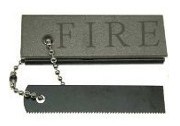The Colorado flooding earlier this year washed away highways, interstates and even small towns. In its wake, it left behind another lesson on disaster clean up and preparedness.
The storm
Heavy rainfall hit on September 9, and didn’t let up until Sept. 13. The storm front was trapped against the Rockies, which meant four days of heavy rain. Rainfall totals equaled 14.62 inches — about two-thirds of the annual rainfall for the area.
The aftermath
Nine people died in the flooding, and many, many more lost their homes. Eighteen towns, including Denver, were hit by flash flooding. Smaller towns high in the mountains were hit particularly hard, and assistance was a long time coming thanks to roads being completely washed out. In many places, only bedrock is left where asphalt used to be — a state that could remain until 2015.
Left without options for getting down the mountain, Colorado flood survivors can only wait for roads to be rebuilt. In Drake, bridges spanning canyons were washed out. Residents have about four hours each day to drive before road crews close them down to work on them. However — road crews are working to fix the roads, which is more than semi-stranded Glen Haven residents can claim. Work on rebuilding the state continues at different paces. Some towns are quickly being rebuilt, while others wait for road crews to get to them. It’s been hard for truckers to get to Colorado cities to resupply towns, which only exacerbates the problems.
The aid
Truckers moving through the state have utilized the Hours of Service Waivers. This gives them permission to skip the otherwise mandated 30-minute break. Each half-hour saved gives truckers more time to reach Colorado with supplies of water, food and other necessities. The roads have been described as “not for the faint of heart” by Greg Fulton, president of the Colorado Motor Carriers Association.
Truckers typically rely on their fleet management software to guide them through routes, but the status of several major roads remained unknown several weeks after the flooding. With spotty information, truckers have to navigate on their own through potentially treacherous situations. About 30 bridges have completely collapsed, and 20 were heavily damaged.
The history
After a disaster, truckers are usually the second to make it to a scene — right after rescue helicopters. Before Katrina even hit, Wal-Mart had 45 trucks on standby, ready to make the drive in. By the end of the clean-up, 1,500 trucks from Wal-Mart alone had made it in and out of an inhospitable zone.
It’s a regular pattern — disasters happen, and truckers go in with aid supplies. They’re often there before roads are fully mapped out, which means hitting sections of road that just aren’t there. How do they manage? Radios and stations like Sirius XMs Road Dog Trucking News. The station has been listing updates on social media and over the airwaves.
Truckers are a resourceful bunch, which means that relief aid is usually able to get to where it needs to be as soon as possible. We still have a lot to learn about preparing for disasters and cleaning up after them, but at least we have an industry dedicated to helping us.










